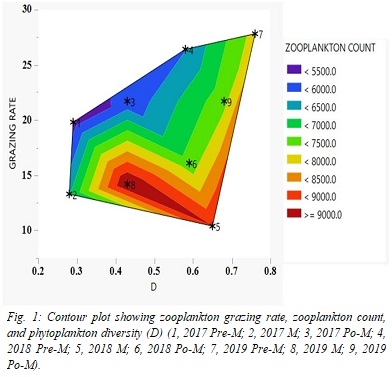 The Netravathi estuary is a micro- to mesotidal, tropical, shallow estuary with an abundant density of phytoplankton. The impact of the zooplankton grazing rate and the selected environmental variables on the phytoplankton community structure was studied seasonally from 2017 to 2019. Microplanktons of centric diatoms such as Skeletonema costatum and Cosinodiscus radiatus dominated during monsoon seasons, whereas dinoflagellates such as Peridinium sp. and Ceratium furca were observed in high numbers at the estuary during non-monsoon seasons. Water temperature showed a strong association with grazing rates of microzooplankton (r = 0.910). Canonical correspondence analysis studies established an intensification in grazing rate during non-monsoon seasons by calanoid copepods which in turn occasioned the reduction of microplanktons belonging to diatoms. Moreover, during monsoon seasons, diminution in grazing rates of calanoid copepods coupled with the presence of micro larvae as a secondary consumer of zooplankton resulted in the proliferation of centric diatoms. The grazing behaviour of microzooplankton affected the phytoplankton species diversity of the estuary in a negative manner (D = 0.29 in 2017 Pre-M, D = 0.76 in 2019 Pre-M). Selective grazing behaviour of calanoid copepods concerning temperature alteration exerted a strong influence in determining the phytoplankton community structure of the estuary to a great extent.
The Netravathi estuary is a micro- to mesotidal, tropical, shallow estuary with an abundant density of phytoplankton. The impact of the zooplankton grazing rate and the selected environmental variables on the phytoplankton community structure was studied seasonally from 2017 to 2019. Microplanktons of centric diatoms such as Skeletonema costatum and Cosinodiscus radiatus dominated during monsoon seasons, whereas dinoflagellates such as Peridinium sp. and Ceratium furca were observed in high numbers at the estuary during non-monsoon seasons. Water temperature showed a strong association with grazing rates of microzooplankton (r = 0.910). Canonical correspondence analysis studies established an intensification in grazing rate during non-monsoon seasons by calanoid copepods which in turn occasioned the reduction of microplanktons belonging to diatoms. Moreover, during monsoon seasons, diminution in grazing rates of calanoid copepods coupled with the presence of micro larvae as a secondary consumer of zooplankton resulted in the proliferation of centric diatoms. The grazing behaviour of microzooplankton affected the phytoplankton species diversity of the estuary in a negative manner (D = 0.29 in 2017 Pre-M, D = 0.76 in 2019 Pre-M). Selective grazing behaviour of calanoid copepods concerning temperature alteration exerted a strong influence in determining the phytoplankton community structure of the estuary to a great extent.
Bibliographic Info: Ratheesh Kumar, M., Anoop Krishnan, K. [2021]. Grazing behaviour of tropical calanoid copepods and its effect on phytoplankton community structure. Environmental Monitoring and Assessment, Vol. 193 (8), Art. 495. https://doi.org/10.1007/s10661-021-09306-5




 RTI Act
RTI Act
